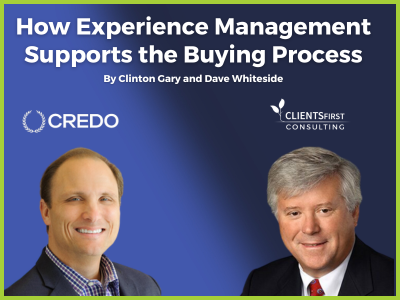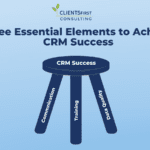How Experience Management Supports the Buying Process

For years we have advocated that the two most valuable assets of a law firm are its collective relationships and experience. Like a track relay team passing the baton, relationships create opportunities and experience wins opportunities. Before you can generate more revenue, you have to create and win more opportunities. That’s sales. And to amass a firm’s collective capabilities and select the most relevant to achieve the desired outcome. That’s experience management.
The question is – why don’t more firms invest in a robust experience management program to support their significant investment in their originating professionals – namely key client relationship partners, sales-oriented professionals, and marketing and business development teams – to create and win more opportunities?
How Did We Get Here?
“Experience Management” (EM) was initially seen as a non-billable activity instead of a strategic investment of time. Experience management was relegated to the discrete operational area of more efficient proposal creation. This short-sighted, tactical approach relegated most EM programs to mediocrity.
Today, experience management is coming back to the forefront as firms have invested significantly in talent to meet more complex clients’ needs and service demands. EM leverages this investment by helping law firms expand their collective capabilities into a competitive advantage that drives growth.
In this article, we cover how an experience management program can enhance each phase of the sales process and make a compelling case for firms to invest more in their EM programs to improve sales performance, create a more compelling experience for the buyer, and generate greater growth.
The Buying (Selling) Process
Let’s utilize a sales model developed by Jason Mlicki, Principal with Rattleback, a marketing firm for professional services, which he calls the Arc of the Client’s Journey. The Arc represents the four stages a client goes through to become a client.
- Learning — Researching a big issue or critical business challenge.
- Vetting — Pre-qualifying potential solution providers.
- Discussing — Exploring their available options.
- Hiring — Negotiating an agreement to move forward.
Let’s apply experience management to this process.
#1 – Learning
Historically, clients and professionals initiated conversations with outside counsel to create leads. Today, clients research their issues via their preferred digital channels (before contacting outside counsel).
How Experience Management Supports this Stage
- Law firms can create credible content, real-world case studies and success stories based on experience, that demonstrates the firm’s differentiating expertise and service in handling significant legal issues. This is important because “stories” are considered a more powerful form of content for engagement and persuasion. In this phase, an executive wants to find themselves in a story.
- A good experience management program can help identify clusters of experiences that can serve as the foundation to develop effective industry-specific thought leadership. And by “effective,” we mean the kind that is so compelling that it removes the buyer’s option of doing nothing, which is the greatest obstacle in the sales process.
#2 – Vetting
Once a buyer has framed an issue in their minds, they begin to assess the potential firms that emerge. This is where legal buyers filter firms by asking:
- Do you understand my problem?
- Do you understand my business?
- Have you solved a problem like mine?
- Have you solved it for a company like mine?
How Experience Management Supports this Stage
- Given that this vetting process is still predominantly performed through digital channels, a firm should manage its experience appropriately, so it can be offered through the firm’s website to empower the buyer to answer these questions. This includes the ability to do complex searches, such as “M&A (service) > Pharmaceuticals (industry) > Northeast (Geography).” We see a significant number of searches that involve multiple variables and keywords.
- Rankings can be painful in the creation of a compelling submission that actually represents the firm’s best recent experience. However, an EM program that is woven into the firm’s culture and attorney’s work processes makes rankings no longer a painful moment but a search of the database for relevant experience that only needs refinement.
#3 – Discussing
This is usually the phase when proactive connections and meaningful conversations begin to happen. These discussions may be conducted informally or formally (RFI/RFP) or a combination.
How Experience Management Supports this Stage
- A robust EM database allows quick searches for “best of” experiences to form elevator pitches and conversational pieces that advance a more seamless and authentic process, rather than “Yes, we do that” or “Let me get back to you.”
- Expanding EM to include experience, skills, aspirations, availability and other valuable characteristics for each professional helps our lead professionals more easily identify colleague attorneys to bring into the conversation to advance the process with more in-depth knowledge. This extends to strategically staffing engagements for diversity and talent, not bound by geographic and practice silos. Think of it as an “internal LinkedIn” for your firm.
- When a proposal request does arise, an integrated EM system positions your marketing and BD team to respond to requests more efficiently and effectively that includes the “best of” experience at all levels and more detailed statistics on outcomes (i.e., matters to trial and won), avoiding the lead partner or professional from using precious political capital in fire drills for updated experience.
#4 – Hiring
Here a potential client transitions from exploring their options through direct conversation to hiring a firm, team, and attorney and moving forward. This is when our professional leading the sales process needs to assemble a pitch team, negotiate details, and provide the client the confidence in our approach.
How Experience Management Supports this Stage
- Returning to the power of stories. In the pitch, will you show a 30-slide PowerPoint of bios and firm accolades? OR will you spend time listening to their issues and needs, and tell stories of service and success (strategically selected and rehearsed for a compelling buyer experience), build trust, and get to “yes?”
- EM programs that capture assets related to an experience or matter, such as a proposal, pricing calculation and project plan can support more effective negotiations and efficient project management (“don’t reinvent the wheel”).
Law firms aspiringly espouse to being “One Firm”. This is challenging today in our ever-expanding and complex firms, as there is constant growth and change. Success in today’s legal world demands the critical ability to harness and leverage the firm’s collective and individual experience and capabilities to bring “One Firm” to the sales process.






